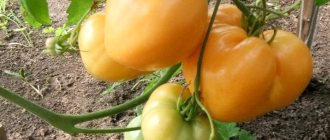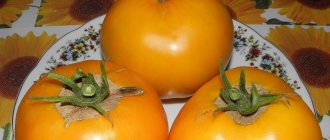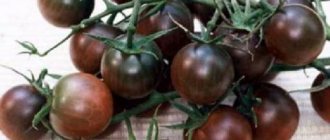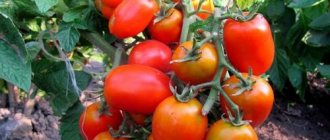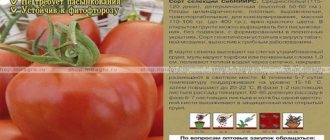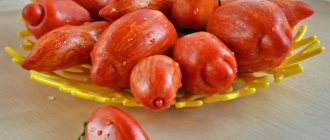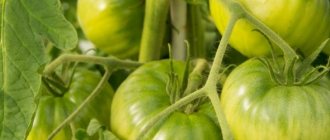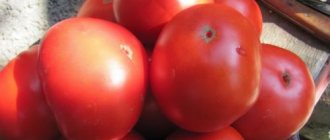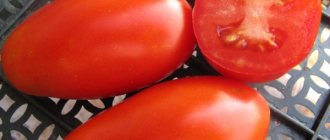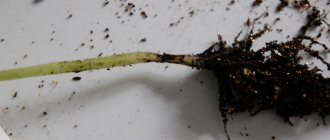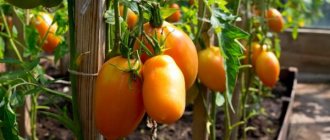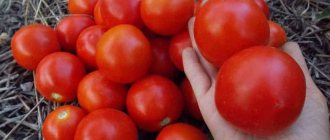Description of the tomato variety Cosmonaut Volkov with photo
The variety is not included in the State Register of Breeding Achievements, but is known to many summer residents. It is named after the Soviet pilot-cosmonaut V.N. Volkov, who tragically died in space due to depressurization of the apparatus in 1971.
Main characteristics of the variety:
- indeterminate (grows without restrictions);
- tall (130-200, less often up to 230-250 cm);
- mid-early (fruits are formed in 100-110 days).
The bush is standard (no lower shoots), quite tall, with strong shoots. The leaves are green, of typical shape and size, densely covering the bush. The inflorescences are simple, the first of them is planted above the 9th leaf, then every 3rd. The peduncle has a pronounced articulation. From 5 to 9 large Cosmonaut Volkov tomatoes ripen on one bunch.
Distinctive features
The type is indeterminate, tall, up to 2 m high. The first cluster is tied above the 9th leaf, the subsequent ones - every three leaves.
A mid-early variety, it takes 110-120 days from the first shoots to full ripening.
The productivity is high, up to 7 kg of fruits are harvested from 1 seedling, provided that no more than 3 plants are planted per 1 square meter. m.
The variety is distinguished by its stable immunity to many dangerous diseases of the nightshade family. Recommended for cultivation in open and protected ground, perfectly adapted to any climatic conditions.
The culture requires obligatory staking and pinching of tall bushes.
Description of the bushes
The tomato bush is indeterminate (has unlimited growth, in good weather it can grow quite high). The bush is powerful, up to 2 m high, so it should be pruned if necessary.
Description of fruits
Tomatoes are large, on average weighing 300-400 g, diameter 10-12 cm or more. There are specimens up to 800-900 g. The surface has pronounced ribbing, glossy, rich red or pink. Cosmonaut Volkov tomatoes have an oval shape with a noticeable flattening at the top and bottom. There are 5-6 seed chambers, there are few seeds in them. It can be collected because it is a variety and not a hybrid - therefore, the new offspring will also bear fruit.
The pulp is very tender and juicy, dense, fleshy consistency, not watery. The taste is excellent - many rate these tomatoes as “excellent”. There is a balance of sweet and light sour notes, and a pleasant tomato aroma.
Cosmonaut Volkov tomatoes are very large, with an interesting taste and aroma
Important! The largest tomatoes appear at the bottom of the bush. To prevent them from bending it to the ground, the plant is tied to a support.
Appearance of tomatoes
The fruits of the Cosmonaut Volkov tomato have a typical “tomato” color, close to bright red, and a beautiful flat-round, aligned shape, large. The appearance evokes a feeling of excellent taste, which is justified in practice.
Tomato fruits Cosmonaut Volkov - a “classic” of large red tomatoes
Basic qualities of fruits
The fruits are flat-round, slightly ribbed at the stalk, large, red in color at maturity, weighing up to 500 grams, very good taste. These tomatoes are good for fresh consumption and making juice and sauces.
A very productive variety!
Tomato yield Cosmonaut Volkov : up to 5 kg of fruit from 1 plant (with proper agricultural technology).
Seed producers : agricultural company Aelita, Sedek, Russian Garden, Successful Seeds.
This tomato variety is not included in the State. register of selection achievements in the Russian Federation.
Fruit characteristics
The fruits are large, with an average weight of 500-650 g. The vegetables on the lower branches are the largest, their weight reaches 800 g. The shape is round, strongly flattened on top, the color is bright red. The taste is excellent, sweet, harmoniously combined with sourness. The pulp is juicy and fleshy. There are 6-7 seed chambers.
The purpose is universal: tomatoes are suitable for preparing fresh dishes and winter preparations. Ripe vegetables are processed into juices and ketchups. Despite their large size, the fruits are stored for a long time without loss of quality. Tomatoes also withstand long-distance transportation very well.
The photo shows Cosmonaut Volkov tomatoes.
Area of application of fruits
Thanks to their excellent taste and juiciness, these tomatoes can be consumed straight from the plant, in any dish (sauces, soups) or sent for processing:
- tomato juice;
- paste;
- mashed tomatoes;
- lecho, horseradish, adjika and other preparations.
Tomato types in general are not suitable for canning because they are too large.
Characteristics of tomatoes Cosmonaut Volkov
Before purchasing seeds for planting, take into account the characteristics of hybrids. This includes yield, ripening period, use, immunity to external factors.
Resistance to diseases and pests
The variety is mid-season, so it rarely suffers from late blight. However, this is only true if the tomatoes are picked early and sent for ripening. There is no data on resistance to other diseases and pests. Therefore, as a preventive measure, it is recommended to carry out standard treatment with fungicides before transplanting seedlings into the ground. Repeated procedures are carried out as necessary.
Tomato productivity Cosmonaut Volkov and fruiting
Tomato is a very productive plant. When grown in a greenhouse, you can harvest up to 6 kg from 1 plant. Moreover, there is evidence that in good weather they get even 9-10 kg of tasty tomatoes.
| Conditions | Greenhouse | Open ground |
| From 1 bush, kg | 5-6 | 4-5 |
| From 1 m2, kg* | 15-18 | 12-15 |
Tomato bushes Cosmonaut Volkov are very spreading and form several stems. Therefore, no more than 3 plants can be planted per 1 m2.
Productivity depends on various factors - primarily on growing conditions (preferably in a greenhouse) and on the characteristics of care. To get the largest number of tomatoes, Cosmonaut Volkov recommends following several important rules:
- Regular watering and fertilizing.
- Pinching, formation of 2-3 stems.
- Tying to a support.
- Ventilate the greenhouse, especially after watering and in hot weather.
Growing tomatoes: what to pay attention to
The tall tomato variety Cosmonaut Volkov is grown in the middle zone as seedlings, planting tomatoes in greenhouses or in beds in early or mid-May. For the regions of Siberia, the Urals, and the North-West, it is recommended to plant tomatoes in shelters, where, with good care, they will reveal their full potential.
Here are some care tips:
- Sowing seeds for seedlings - late February or early March. When planting, the tomatoes should be 60-65 days old.
- The volume of cups or pots for seedlings should be at least 0.8-1 liters. Small containers are not suitable for powerful large-fruited plants.
- Be sure to provide additional illumination to the seedlings in March-April using fluorescent lamps or special lamps.
On a note! With sufficient light in the first months of growing plants, they will be strong, with small internodes, and stocky.
- 10-14 days before planting, tomatoes begin to harden, gradually accustoming them to outdoor temperatures.
- Plants are planted when the soil warms up to +14ºC.
- Planting scheme – 2-3 bushes per 1 sq. meter.
- Tomatoes are grown using trellises with obligatory staking of shoots.
- The bushes are formed into 1-2 stems, removing excess shoots.
- About a month before the end of fruiting (early August), the top of the stem is pinched.
- The harvest is harvested in a state of technical ripeness of the fruit, allowing only the tomatoes from which it is planned to take seeds to fully ripen on the bushes.
The legendary variety Cosmonaut Volkov does not give up its position even after years. The main thing is to provide the plants with good care and all efforts will be rewarded.
Advantages and disadvantages, features of the variety
In the first years after its appearance on the market, the Cosmonaut Volkov tomato was considered one of the best in its segment, and it has not lost its advantages to this day. The most important of them are:
- high productivity;
- good immunity to diseases;
- high adaptive abilities to the vagaries of the weather;
- large fruit;
- excellent tomato taste;
- versatility of use;
- good transportability of the crop;
- long-term fruiting.
Gardeners' opinion about the variety
Reviews about the Cosmonaut Volkov tomato are only positive. Gardeners who have been growing this crop for several years leave a positive description:
- the seeds have good germination, the seedlings take root well after transplantation and produce a good harvest, provided that all the rules of agricultural technology are followed;
- universal cultivation - the possibility of planting in a greenhouse and in open ground, qualities that attract gardeners both in the south and north of the country;
- good and stable productivity - thanks to these qualities, tomato is cultivated both in private and industrial gardening.
How to grow seedlings
Sowing of seeds begins 2 months before planting seedlings in the ground. Seed material is purchased in specialized stores or prepared independently. Purchased seeds do not require processing. Only those grains that were collected independently undergo special preparation before sowing.
Sowing time
Tomato seeds for seedlings should be planted in early March or late February. Planting time depends on the weather and conditions of each individual region. If the weather permits, you can plant the seeds earlier than the specified time.
Seed preparation
The seed material is checked for suitability by placing it in a saline solution for 10 minutes. Those that float to the surface are empty, they are disposed of. Afterwards, the seeds are placed for 20 minutes in a weak solution of potassium permanganate. Thus, the grains are disinfected. After disinfection, they are washed with running water.
To improve germination, grains are germinated on damp gauze for 2-3 days. The place for germination is chosen dark and warm, with a temperature of at least 26°C. As the gauze dries, lightly moisten it with warm water. After the first sprouts appear, the seeds are sown in the ground.
Container and soil
The soil is prepared from garden soil mixed with humus in equal quantities. To make the soil lighter, washed river sand is added as a loosening agent. After thoroughly mixing all components, the soil is disinfected to destroy pathogenic flora.
To do this, pour it with a hot solution of purple potassium permanganate or steam it in the oven for at least 15 minutes at a temperature of 50°C. The cooled soil is laid out in planting containers, having previously made small drainage holes at the bottom so that excess moisture drains into them.
Plant in a common wooden box or in separate containers. From individual containers, peat pots are preferable, as they simplify further care.
Reference . The walls of peat pots feed the young roots with additional beneficial substances throughout the entire period of seedling growth.
Sowing
The seeds are sown in grooves 2 cm deep, sprinkled with soil on top and watered generously with warm, settled water along the edge of the containers. Then the containers are covered with film or glass and left in a warm and dark room at a temperature of 22-24°C.
Further care of seedlings
When seedlings appear, the containers are moved to a well-lit place, on the windowsill. The duration of daylight hours is at least 13 hours. If there is a lack of natural light, add phytolamps.
Water the soil as the top layer dries out with warm, settled water, without flooding the seedlings. For watering, use a small watering can or a regular tablespoon. Afterwards, the soil is loosened, thereby improving the penetration of oxygen. To accelerate the growth of seedlings, add a Nitrophoska solution to the watering.
When 2 true leaves appear, the seedlings are picked and placed in separate containers. The picking procedure involves removing the main root by one third. During picking, weak and non-viable plants are disposed of. If the seeds are sown in peat pots, picking is not required.
Reference . Diving helps to strengthen the root system, since after the procedure the lateral roots are intensively built up.
2 weeks before transplantation, young plants begin to harden, thereby helping to adapt to new conditions. To do this, the containers are taken outside in the daytime for 1 hour, gradually increasing this interval to 11-12 hours. At the same time, the night temperature is reduced to 13°C.
Hardening of seedlings
10-14 days before planting in the ground, seedlings need to be hardened, that is, prepared for more severe real conditions. To do this, the seedlings are transferred to a cooler room, so they get used to the drop in temperature, which should not fall below +8 °C. It is prohibited to harden seedlings in drafts and in places with direct sunlight.
When hardening, seedlings should be taken out into fresh air, but for no more than 30 minutes. The hardening process must be systematic. If all the rules are followed, the plant will be able to tolerate frosts down to -5 °C. A couple of days before planting seedlings in the ground, they need to be sprayed with a solution of copper sulfate, adding to it any biological preparations for fungal diseases.
Important! The favorable temperature for plant growth should be +22…+24 °C.
Features of cultivation
Seeds for sowing can be either purchased in special stores or prepared yourself. In order to prepare the seeds you need:
- In the summer, when the fruits begin to ripen on the bushes, let the fruit become overripe.
- Pick overripe fruit and let it rot.
- Collect seeds from this fruit, dry them and store until the seedling season.
Before preparing seedlings, the seeds must be treated, that is, disinfected. This procedure can be done using a solution of potassium permanganate. Prepare a solution and soak tomato seeds in it for 15-20 minutes. While the seeds are being disinfected, we prepare a container for harvesting seedlings.
It is very convenient to use plastic bottles with a capacity of 1–1.5 liters for harvesting seedlings. In such a container, seedlings can be stored directly in an apartment or house on a windowsill until the time of planting them in the soil. Place cut polystyrene foam measuring approximately 1 by 1 cm at the bottom of the bottle to create a drainage effect. Then fill it with soil, which you can buy at a gardening store, and sow tomato seeds. Seedlings are prepared 2 months before transplanting into the ground.
When transplanting seedlings into open ground, the bushes of “Cosmonaut Volkov” must be planted from each other at a distance of approximately 70 cm. Due to the fact that the tomato bushes are tall, and also that the fruits reach a large weight, the stems of the plant must be tied up, and the soil drain.
To obtain a good harvest, it is necessary to water the bushes in a timely and abundant manner, remove weeds, weed, as well as properly feed with fertilizers, and carry out preventive measures against harmful insects and diseases.
Landing
For 1 sq. m place no more than 3 plants in a checkerboard pattern. This method of planting allows each bush to receive sufficient sunlight and be regularly ventilated.
The seedlings are transferred into holes 20 cm deep along with a lump of earth. Then the holes are covered with soil and watered abundantly with warm, settled water. Full care begins after 2 weeks, when the young bushes finally adapt to the new conditions.
Reference . There is no need to replant seedlings from peat pots. They are lowered into the hole along with the container. The pots dissolve in the ground without causing harm to the root system, and continue to feed the roots with useful substances.
Transplant timing
After 2 months, after the first shoots appear, the seedlings can be planted in a permanent place. If the weather is warm and favorable, the landing can be carried out earlier.
How to grow tomatoes
After 2 months, the seedlings are ready for planting in the ground. The soil is prepared in the fall - dug up and fertilized with compost. If the soil is clayey, it is diluted with sand and humus, since tomatoes love light and fertile soil.
Watering
This plant loves moisture, but in moderation - from a lack, the fruits are not so large, juicy and tasty, and from excess - watery.
The first moistening of the seedlings is carried out a week after transplanting to the garden bed. 1 liter of water is poured under the root of each bush. All subsequent waterings are carried out as the soil dries out.
Be sure to water tomatoes before flowering and at the stage of fruit filling - this will improve the quality of both processes.
Feeding
Fertilizer is placed in the ground at the time of planting tomatoes, and then the plant is fertilized every 10 days. Before fertilizing, water the bush, this helps to distribute the fertilizer evenly in the ground.
Complex (phosphorus and potassium) fertilizers are suitable for feeding; their nutritional elements contribute to better growth of tomatoes.
Important! Fertilizer application rule: per 1 sq. m need to apply no more than 30 g of fertilizer.
The tomato variety “Cosmonaut Volkov” brings a huge harvest, it is unpretentious and quite easy to care for. Suitable for any type of use. Stable yields, disease resistance and good taste are attracting an increasing number of gardeners, so this tomato is very popular, despite the fact that it was bred by an amateur breeder.
Loosening and mulching
Regular weeding and loosening of the soil increases its moisture and breathability qualities, and this is important for the development of the bush and further productivity.
To protect against lodging and drying out after watering, the area under the bush is covered with garden soil.
As they grow, weeds are removed, which choke the plantings and provide an excellent breeding ground for pests and infections.
Stepsoning
Pinching is the removal of excess shoots that are located in the axil of the plant, between the stem and leaves. Different bushes produce stepsons in different ways.
The “Cosmonaut Volkov” tomato is an indeterminate plant, so it is planted by cutting off shoots 7-8 cm long, and the shoots must be cut off, leaving approximately 1-2 cm from the edge of the base, to prevent re-growth of the shoots. This method removes all the stepsons, the bush does not thicken and the yield level does not decrease.
Formation
Formation of a bush increases productivity.
To obtain larger fruits, formation of 3-4 stems is carried out. After the formation of the first brush, pluck out all the stepsons and leaves under it. As it grows, 2 or 3 stepsons are left above the flower brush, the remaining parts are removed.
Garter
Before the fruits begin to form, each tomato cluster is tied up so that the ripened fruits do not damage the bush under their weight.
Features of growing in a greenhouse and open ground
Difficulty in care arises due to the large size of the bush. You have to build a trellis to which the stem and branches of the plant are tied. It is not always possible to tie up all the branches. Additional supports are often required for heavy bunches of fruit.
The lower branches are the least convenient for fixation. Vegetables of the greatest weight ripen on them, which bend the fruiting clusters to the ground. If these branches are left unfixed, constant contact of vegetables with wet beds will cause them to rot and increase the risk of developing fungal infections.
Tomato does not like frequent watering; it is better to water less often, but abundantly. Incorrect watering regime affects the quantitative indicator of fruiting. In addition, ripe vegetables may have a watery taste.
When planting in a greenhouse, the top layer of soil must be replaced every season. Larvae of insect pests and pathogenic spores successfully overwinter in the ground, which begin to develop in the spring, causing harm to healthy plants. The introduced soil must be disinfected by spilling it with a solution of potassium permanganate and treating it with copper sulfate.
According to the rules of crop rotation, tomatoes are planted in the same soil where legumes, cabbage, zucchini, and winter crops previously grew. After them, the soil is not depleted, but, on the contrary, is filled with nitrogen, necessary for the full development of tomato crops.
In the greenhouse
The transfer of seedlings to greenhouse conditions occurs on the 45-50th day of plant growth and development. The soil in greenhouses for growing tomatoes is updated annually. Mineral and organic fertilizers are added to the prepared soil. Before planting seedlings, the soil is additionally treated with antibacterial compounds.
Watering in greenhouse conditions is carried out no more than once every 7-10 days. Otherwise, high humidity will develop in the greenhouse, which will provoke diseases and pests.
Also, due to the increased air humidity during the flowering period, tomatoes need help with pollination. Pollen becomes heavy from moisture and is not transferred from flower to flower, which negatively affects the yield of the vegetable crop.
Important! Daily ventilation of the greenhouse will greatly simplify the care of tomatoes and reduce the risk of developing lesions and unwanted insects.
In the open ground
Beds for planting seedlings in open ground are prepared in the fall. The area for planting vegetables is chosen to be level, with good lighting and shelter from drafts. The soil on the site is dug up deeply, mineral and organic fertilizers are applied, and thoroughly loosened.
In the spring, before planting, the beds are loosened again. Planting holes up to 30 centimeters deep are dug in each bed. The distance between plants is kept from 40 to 50 centimeters, between ridges - up to 70 centimeters. The seedlings, along with a lump of earth, are transferred to the hole and dug in.
The planted tomato is watered and tied to a supporting structure.
Important! Cosmonaut Volkov tomatoes grow and develop quickly, so they require constant monitoring when tied to supports.
During the growth process, vegetable crops require timely watering, fertilizing, loosening the soil and forming bushes. Watering is carried out as the soil dries, pouring up to 5 liters of warm, settled water under each bush. Vegetable crops are fed 3-4 times during the growing season, using mineral fertilizers based on potassium and phosphorus. Loosening the soil and removing weeds is carried out together with watering.
To reduce plant care activities, the beds are mulched with straw or sawdust mixed with peat. Due to the rapid growth and development of bushes, plants are tied once a week. Measures to remove excess stepsons are also carried out at least once every 5-7 days.
Important! Removing excess shoots allows you to increase productivity and reduce the ripening time of vegetables.
Features of care and possible difficulties
The height of the plants requires staking. It is most convenient to tie tall bushes to a trellis. To do this, supports are installed on different sides of the bed and wire is pulled between them. The stems and branches of plants are fixed to a horizontally stretched wire. If there are few bushes, they are tied to wooden stakes installed next to each seedling during transplantation.
Growing rules
The key to good growth and high yield of bushes will be the selection of high-quality seeds, soil and planting care.
Tomatoes should be sown for seedlings at the end of February or early March. 55-60 days before planting in the garden, they will get stronger, grow a stem 25-30 cm high, 2-3 pairs of leaves and long roots.
Seed preparation
Seeds of the Cosmonaut Volkov variety can be purchased at any gardening store
The main thing when purchasing is to pay attention to the expiration date, because... expired seeds have a low germination rate
Tatyana Orlova (Vasilidchenko) (candidate of agricultural sciences):
On the seed packets, the manufacturer indicates the shelf life during which the seeds are guaranteed to germinate. If there is a date on the package, for example, “December 2021,” this does not mean that in January 2021 the seeds will no longer be viable.
You can also get seedlings from tomatoes grown on your own plot. They are separated from the pulp, washed and dried. Then they go through several stages.
- Rejection. You can select high-quality specimens that will produce good seedlings by pouring them into salt water for half an hour (10 g dissolved in 1 liter of water). All that float up are disposed of, and those that sink to the bottom are washed under clean water and dried.
- Then they are dipped in a solution of potassium permanganate for 30 minutes to destroy all pathogenic microbes on the surface. Prepare at the rate of 1 g of manganese per 1 liter of water.
- The washed ones are dipped in one of the growth stimulants - Epin, or Zircon. Soaking time - 40 minutes. After this treatment, the seeds germinate and take root better.
- 2 days before sowing, spread evenly on a damp cloth, irrigate with warm water, wrap and place in a cool, dark place for 48 hours. During the aging period, they need to be sprayed several times so that they do not dry out. Moisture will help them swell and hatch, which will speed up the germination process.
Tatyana Orlova (Vasilidchenko) (candidate of agricultural sciences):
Tomato seeds must be germinated at a temperature not lower than +25 degrees. In a cool room this process will take a long time.
Landing capacity
Any container must have drainage holes
Different containers are used for sowing:
- seedling boxes or plastic containers 10-12 cm high;
- disposable cups or peat pots with a volume of 400 ml;
- cassette.
The main condition for the planting container is the presence of drainage holes for the drainage of excess moisture, otherwise the soil will become moldy, and with it the young shoots.
Priming
This garden crop likes to grow in light and loose soil with a neutral acidity level. For better growth and development, organic and mineral fertilizers are added to the soil. Spend 1 tbsp per bucket of soil. l. superphosphate and potassium sulfate, 500 g of wood ash, 2 kg of humus (compost), ½ bucket of sand.
Before placing it in a planting container, the soil is disinfected in any convenient way - a strong solution of potassium permanganate, poured with boiling water or steamed in the oven at a temperature of 180°C.
Technique
The scheme and rules for sowing tomato seeds depend on the type of container used:
- when sowing in groups in boxes or containers, make grooves at a distance of 5 cm, then lay out the seeds, keeping a distance of 2-3 cm;
- Make a small hole in a disposable container and place 1-2 pcs. for one glass or pot.
Planting depth is 1-1.5 cm; if you sow deeper, the seeds will germinate later than usual, some of them may not germinate at all.
The seeds are sprinkled with a light, loose mixture of sand and garden soil (1:1), irrigated with warm water and covered with any transparent material (film, glass).
Crop care
The speed of seedling germination depends on the conditions of detention. Seedling boxes are placed in a warm place with diffused daylight, ensuring a stable temperature within 21-23°C, humidity not higher than 60%.
- daily ventilation for half an hour to avoid the formation of condensation and mold on the surface of the soil;
- irrigation with settled room water as the top layer of soil dries;
- weed removal.
After about 7-9 days, you can expect a massive appearance of sprouts. After this, the shelter is removed, and the containers with seedlings are placed on a southern or southwestern windowsill with the possibility of shading during the midday.
When sowing in groups, the sprouts need to be planted in separate pots. This procedure is carried out at the stage of formation of the first two true leaves.
First, the crops are watered abundantly; after an hour, each seedling is carefully removed and transferred together with a lump of earth into a container (a glass or a pot).
The resulting voids are filled with a nutritious soil mixture of ordinary soil and last year's manure (1:1). For better survival, seedlings are moistened, then with a urea solution (15 g per bucket of water). Consumption per sprout - 50 ml.
Harvesting and application
The harvest is harvested in late July - August. Ripening is amicable, with whole clusters. It is important to try to prevent the fruits from overripening, because the branches, despite reliable fixation, find it difficult to hold heavy vegetables.
The purpose of tomatoes is universal: tomatoes look great in a salad, complement the taste of first and second courses, and are good in vegetable stew. They make excellent freshly squeezed juice.
For canning and marinades, vegetables are used cut; for whole-fruit rolls they are too large. Tomato products (juice, paste, adjika, ketchup) give a rich red color and excellent taste, maintaining a sweetness that is harmoniously combined with sourness.
Ripe vegetables are stored for a long time and can withstand transportation over long distances. But the shelf life of the fruits is preserved only if they are properly cared for: abundant but not frequent watering, regular fertilizing and timely tying and pinching the tops of the plants.
Reference . The quality of the fruit depends on the care of the tomatoes.
Advantages and disadvantages
In order to avoid mistakes when growing Cosmonaut Volkov tomatoes, it is necessary to study all the positive and negative aspects of the varietal crop.
Advantages:
- Vegetables ripen with excellent taste characteristics.
- The variety easily adapts to weather conditions.
- As a result of selection, Cosmonaut Volkov tomatoes received natural immunity to fungal and viral infections.
- Ripe fruits are not prone to cracking, retain their presentation for a long time and can easily be transported over long distances.
The variety has few disadvantages, but they are still present:
- The bushes grow tall and spreading, requiring additional supports and careful shaping.
- Due to the ripening of large fruits, vegetables are not suitable for canning whole.
Expert opinion
Stanislav Pavlovich
Gardener with 17 years of experience and our expert
Ask a Question
Important! When growing this tomato variety in a greenhouse, the yield increases significantly.
Diseases and pests
Improper watering and temperature violations contribute to the development of brown spot (cladosporiosis). This is a fungal disease, the preventive measures for which include systematic loosening, moderate watering, removal of weeds and regular ventilation of closed structures.
When plants are damaged, the preparations “Hom” and “Fitosporin” are used. Traditional methods also help, for example, an aqueous solution of iodine (40 drops per 10 liters of water), which is used to water well-loosened areas.
The most dangerous pest for tomatoes is the whitefly, a white moth that damages the leaves. The drug “Confidor” or pheromone traps installed next to the tomatoes help in the fight against it.
Greenhouse spider mites are repelled from bushes by a soap solution that is sprayed on plants, especially the affected areas. And regular ventilation of the greenhouse destroys the parasite’s usual habitat. But do not forget that tomatoes do not like drafts.
Constantly wet beds increase the risk of slug infestations. To prevent pests from around the tomato bushes, sprinkle the ground with ash or ground hot pepper.
